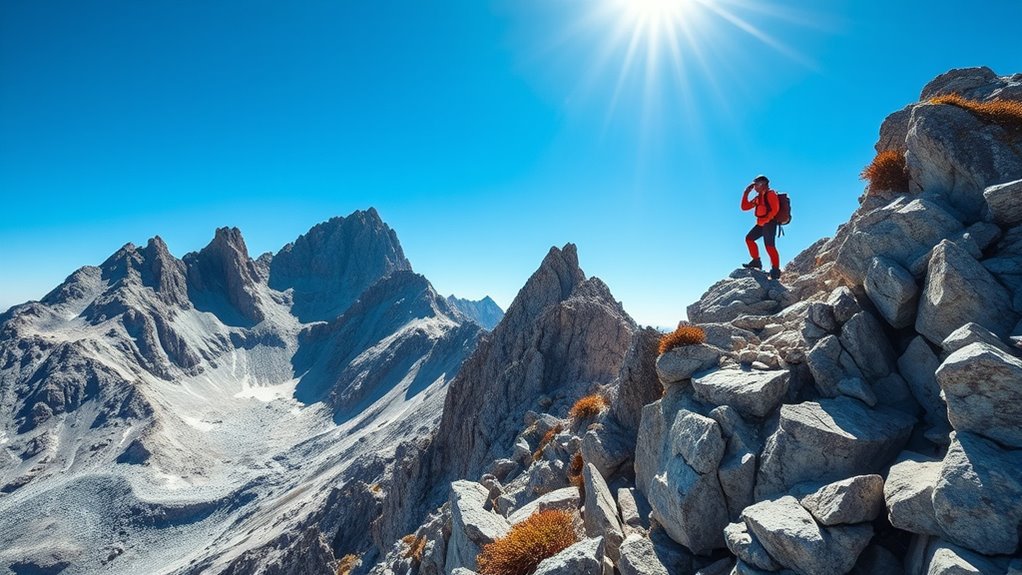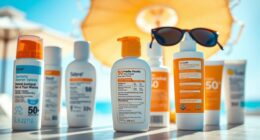At higher altitudes, UV radiation increases because the atmosphere is thinner and offers less protection, raising your risk of skin damage and premature aging. Tanning at these elevations intensifies UV exposure, making skin more vulnerable to burns, wrinkles, and long-term issues like skin cancer. To protect yourself, use high SPF sunscreen, wear protective clothing, and seek shade during peak hours. Continue exploring to discover more ways to safeguard your skin in high-altitude environments.
Key Takeaways
- Higher altitudes increase UV radiation exposure due to thinner atmosphere filtration.
- Elevated UV levels at altitude accelerate skin aging, wrinkles, and age spots.
- Tanning at high altitude intensifies UV damage, raising skin cancer risks.
- Protective measures like sunscreen, clothing, and shade are vital to prevent skin harm.
- Long-term UV exposure at altitude can cause premature aging and long-lasting skin health issues.

When you’re at higher altitudes, your skin faces increased UV radiation, which can substantially raise your risk of sun damage and skin cancer. The thinner atmosphere at these elevations offers less filtration of harmful rays, making UV exposure more intense. With each ascent, you’re exposed to higher levels of ultraviolet radiation, which accelerates skin aging and increases the likelihood of sunburns. Over time, repeated exposure to elevated UV rays can lead to premature skin aging, including wrinkles, fine lines, age spots, and loss of skin elasticity. The sun’s rays penetrate more deeply at higher altitudes, damaging collagen and elastin fibers that keep your skin firm and youthful. Additionally, caffeine consumption can influence skin hydration and health, which is important to consider in high-altitude environments. You might think that tanning at high altitudes is a good way to get a bronzed look, but it actually heightens your skin’s vulnerability to damage. Tanning is your skin’s response to UV exposure, but at altitude, the intensity of UV rays makes this process more aggressive. The more you tan, the more your skin is subjected to harmful radiation, which leads to quicker skin aging. Over time, this damage accumulates, resulting in a dull, leathery appearance and increased wrinkle formation. Besides cosmetic concerns, the elevated UV exposure at altitude raises your risk for serious skin conditions, including melanoma and basal cell carcinoma. Protecting your skin becomes even more critical when you’re in high-altitude environments. Using broad-spectrum sunscreens with a high SPF is essential, and it should be reapplied frequently, especially if you’re sweating or swimming. Wearing protective clothing, wide-brimmed hats, and UV-blocking sunglasses can also make a significant difference. Remember, shade isn’t always enough at altitude because UV rays reflect off surfaces like snow, water, or sand, amplifying your exposure. Staying in the shade during peak UV hours, typically between 10 a.m. and 4 p.m., helps reduce your risk of UV damage and slows the skin aging process. Being aware of the heightened UV exposure at higher elevations means you can take proactive steps to protect your skin. The effects of UV rays aren’t just short-term burns—they contribute to long-term skin health issues and aging. By understanding how altitude influences UV intensity, you can better safeguard your skin’s health and maintain a youthful appearance. The key is consistent protection—wear your sunscreen, cover up, and limit your exposure during the brightest parts of the day. Doing so not only reduces your risk of immediate sunburn but also preserves your skin’s vitality and appearance for years to come.
Frequently Asked Questions
How Does Altitude Affect Vitamin D Production From Sunlight?
At higher altitudes, UV penetration increases, which boosts your vitamin D production from sunlight. The altitude effects mean you’re exposed to stronger UV rays because the thinner atmosphere filters less of the sun’s radiation. So, when you’re at a mountain or high-elevation area, your skin can produce more vitamin D with less sun exposure, but you also face a higher risk of skin damage from intensified UV radiation.
Are There Specific Tanning Risks Unique to High-Altitude Environments?
At high altitudes, you face altitude-specific skin conditions like increased sunburn risk due to stronger UV rays. These conditions make tanning more hazardous, so you should be cautious with tanning equipment safety. The intensified UV exposure can damage your skin faster, increasing the risk of burns and long-term skin issues. Always protect your skin with proper sunscreen and limit exposure, especially if you’re using tanning devices or spending extended time outdoors at high elevations.
Can Altitude Sickness Influence Skin Sensitivity to UV Rays?
Did you know altitude sickness affects about 25% of travelers above 8,000 feet? It can increase your skin sensitivity to UV rays, making you more prone to sunburns. When you experience altitude sickness, your body’s response to environmental stress can weaken your skin’s defenses. Consequently, you should be extra vigilant about sun protection at high altitudes, as your skin becomes more vulnerable to UV damage.
What Protective Measures Are Recommended at High Altitudes?
At high altitudes, prioritize altitude safety by wearing protective gear like broad-spectrum sunscreen, UV-protective clothing, and sunglasses to shield your skin from increased UV exposure. Reapply sunscreen frequently, especially after sweating or wiping. Seek shade during peak sun hours and stay hydrated. These measures help prevent sunburn and skin damage, ensuring you enjoy your time outdoors safely at high elevations.
Does Increased UV Exposure at Altitude Impact Skin Aging Differently?
Like a painter’s palette, increased UV exposure at altitude accelerates skin aging by boosting skin pigmentation and triggering a melanin response. You might notice early signs of aging, such as wrinkles and age spots, more rapidly than at lower elevations. This heightened UV intensity damages collagen and elastin, making your skin less resilient. Protect your skin diligently with broad-spectrum sunscreen, clothing, and shade, especially when you’re high above sea level.
Conclusion
As you venture to higher altitudes, remember that UV exposure increases by about 10-12% for every 1,000 meters. This means your risk of skin damage and tanning accidents rises markedly, even if you don’t feel sunburned. Protect your skin with proper sunscreen and clothing. Keep in mind, at 3,000 meters, UV rays can be nearly 40% stronger—so, taking extra precautions isn’t just smart, it’s essential to avoid long-term skin damage.








